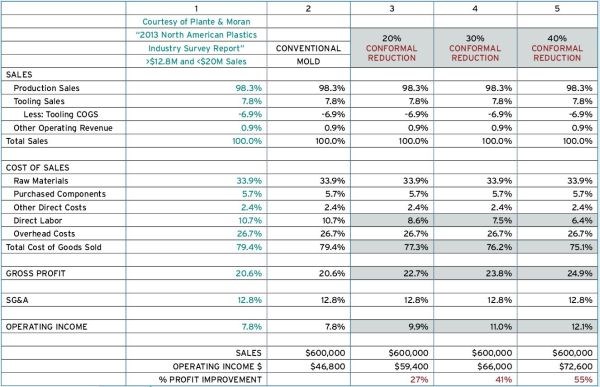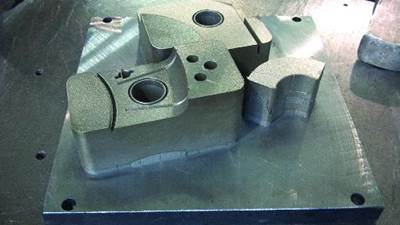Financial Justification of Conformal Cooling
A ratio analysis helps illustrate the estimated effects of conformal cooling on profitability.
There has been a lot of talk in the plastics industry about conformal cooling. It is an industry game changer. Simply put, conformal cooling makes use of cooling lines in an injection mold that closely follow the geometry of the part to be produced. There are a variety of methods for manufacturing a conformal-cooled mold, including laser sintering, vacuum brazing, diffusion bonding and others.
If conformal cooling is implemented with little or no engineering analysis, you can expect to get a 10-percent reduction in injection mold cycle time. However, by performing more engineering analysis, such as flow analysis, computational fluid dynamics (CFD) and finite element analysis (FEA), a better-quality mold and more cycle reduction can be achieved.
A typical cycle time reduction range for a properly engineered conformal-cooled mold is 20 to 40 percent. If little or no engineering analysis is done, you risk premature mold failure or lack of performance because of poor design elements or incorrect assumptions that were not identified and corrected before mold manufacture. Below is an example of a large, complex, vacuum-brazed mold built by Contura MTC GmbH. Depending on the application, Contura will guarantee mold life for 1 million cycles.
The income statement chart shown below, which is based on a ratio analysis (Column 1) published by Plante Moran in its 2013 North American Plastics Industry Survey Report, can be used to illustrate the effects of conformal cooling. I have amended the Plante Moran chart with additional columns and data. For example, since most molds are conventional molds (without the use of conformal cooling), Column 2 uses the same ratios as seen in Column 1. Columns 3, 4 and 5 show the estimated effect on profitability with a 20-, 30- and 40-percent cycle reduction from the use of conformal cooling.

This ratio analysis shows the estimated effect on profitability with a 20-, 30- and 40-percent
cycle reduction for one mold, one press or a whole plant. (Chart courtesy of Robert A. Beard & Associates Inc.)
To simplify the analysis, let’s look at a mold that is in the press 100 percent of the time and generates $600,000 per year in sales. A conventional mold would generate an operating income of $46,800. A conformal-cooled mold would generate:
20% cycle reduction = $59,400 operating income
(27% profit improvement)
30% cycle reduction = $66,000 operating income
(41% profit improvement)
40% cycle reduction = $72,600 operating income
(55% profit improvement)
In this analysis, the engineering analyses and the incremental cost to manufacture a conformal-cooled mold over a conventional mold would be paid for by the “Operating Income $” increases.
Your income statement will most likely vary from this chart. You may want to add more line items for more definition. If so, make the additions. To evaluate different scenarios, change the “Sales” amount near the bottom of the chart and then multiply that amount by the “Operating Income” percentage (above in the same column) to change the “Operating Income $.” This is an analysis method that can be used to see the effect on one mold, one press or an entire plant. This analysis does not take the place of a detailed estimate or quote, however. This analysis is conservative because it only looks at “Direct Labor” and not other factors that might be improved.
The uniform cooling of the mold provided by conformal cooling will decrease rejects due to such issues as warping. Any reduction in reject cost will fall directly into profits. For example, the elimination of each 1 percent in reject rate would add an additional 1 percent to profits. In this analysis, the cost of the engineering analyses and the incremental cost to manufacture a conformal-cooled mold must be factored into an ROI calculation to determine the return on investment versus a conventional mold.
Conformal cooling is a tool to help decrease rejects, which reduces the risk of a costly recall. Therefore, the decision to use conformal cooling should be an easy one for automotive and medical applications, or any application with a high risk of product liability. The cost of a recall is much more than the incremental cost of a conformal-cooled mold.
Also, because conformal cooling yields uniform part cooling, molded-in stress can be reduced. This produces a stronger part, which increases part safety, mitigating part failure and recall risk.
Another consideration is the use of increased press capacity. To keep the math simple, let’s examine a 10-press plant. If a 30-percent cycle reduction is achieved plant-wide, there will be three empty presses on the floor. Assuming that the presses are the same size, then there will be an increase in sales of $600,000 per year for each of the three presses (a total of $1.8 million), producing an additional $198,180 in annual profit (at 11-percent profit, according to the chart). This might also cause an over-absorption of overhead, which would produce a higher profit.
According to the chart, a 30-percent cycle reduction increases operating income by 41 percent. This gives you options. If you don’t have any competition, you can keep all the profit. Or you can keep half of the increase and use the other half to lower your prices to gain more business to fill up those three empty presses. Or you can sell the three presses to free up capital.
If your competition is quoting lower prices, it may already be using conformal cooling.
Related Content
Editorial Guidelines: Editorial Advisory Board
The Editorial Advisory Board of MoldMaking Technology is made up of authorities with expertise within their respective business, industry, technology and profession. Their role is to advise on timely issues, trends, advances in the field, offer editorial thought and direction, review and comment on specific articles and generally act as a sounding board and a conscience for the publication.
Read MoreLeading Mold Manufacturers Share Best Practices for Improving Efficiency
Precise Tooling Solutions, X-Cell Tool and Mold, M&M Tool and Mold, Ameritech Die & Mold, and Cavalier Tool & Manufacturing, sit down for a fast-paced Q&A focused on strategies for improving efficiencies across their operations.
Read MoreDynamic Tool Corporation – Creating the Team to Move Moldmaking Into the Future
For 40+ years, Dynamic Tool Corp. has offered precision tooling, emphasizing education, mentoring and innovation. The company is committed to excellence, integrity, safety and customer service, as well as inspiring growth and quality in manufacturing.
Read MoreThink Safety: Eliminate Hazards Throughout the Shop
The tooling community is taking advantage of new products for safer mold shops and molding facilities.
Read MoreRead Next
Conformal Cooling: A Tool in the Toolbox to Build a Better Mold
Moldmakers are just starting to scratch the surface of what can be done with conformal cooling, which involves an additive approach.
Read MoreAre You a Moldmaker Considering 3D Printing? Consider the 3D Printing Workshop at NPE2024
Presentations will cover 3D printing for mold tooling, material innovation, product development, bridge production and full-scale, high-volume additive manufacturing.
Read MoreReasons to Use Fiber Lasers for Mold Cleaning
Fiber lasers offer a simplicity, speed, control and portability, minimizing mold cleaning risks.
Read More












.jpg;maxWidth=300;quality=90)








